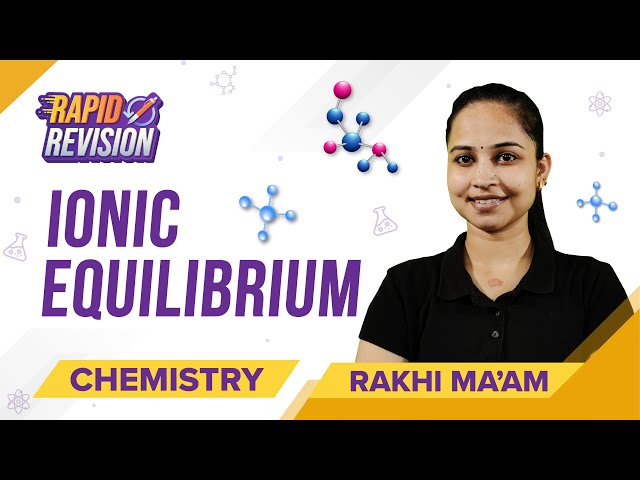Ionic Equilibrium JEE Advanced Previous Year Questions with Solutions given here will help JEE aspirants to revise the important topics before the examination. As aspirants go through the questions and solutions they will further gain better concept clarity and develop adept problem-solving skills. They will also get familiar with the question types, difficulty level and develop the right approach for the entrance exam.
Ionic Equilibrium JEE Advanced Previous Year Question and solutions are also available in the form of a PDF. It can be downloaded instantly and used by aspirants to study when they are offline. In essence, aspirants can go through the given set of questions that have appeared in the various sessions of the entrance exam and boost their overall preparation.
Download Ionic Equilibrium Previous Year Solved Questions PDF
JEE Advanced Previous Year Questions on Ionic Equilibrium
Question 1. A solution of 0.1 M weak base (B) is titrated with 0.1 M of a strong acid (HA). The variation of pH of the solution with the volume of HA added is shown in the figure below. What is the pKb of the base? The neutralization reaction is given by B + HA → BH+ + A–.

Solution: (3.3)


kb = 5 × 10-4
pkb = –logkb = – log (5 × 10-4) = – log5 + 4log10
pkb = 4 – 0.7
pkb = 3.3
Question 2. An acidified solution of 0.05 MZn2+ is saturated with 0.1 M H2S. What is the minimum molar concentration (M) of H+ required to prevent the precipitation of ZnS?
Use sp(ZnS) = 1.25 x 10-22 and overall dissociation constant of H2S,
KNET = 1 2 = 1 × 10-21.
Solution: (0.2)

Question 3. The solubility of salt of a weak acid(AB) at pH 3 is Y × 10-3 mol L-1. The value of Y is___. (Given that the value of solubility product of AB (Ksp) = 2 × 10-10 and the value of ionization constant of HB(Ka) = 1 × 10-8)
Solution: (4.47)
AB ⇌ A+ + B−
S (S − x)
2 × 10-10 = S(S−x)….(1)
B– + H+ ⇌ HB
(S−x) 10-3 x
1 / 10-8 = x / (S − x) × 10-3
X / S − x = 105 ….(2)
Multiply equations (1) and (2).
S.x = 2 × 10-5
From Eq. (1)
S2 − Sx = 2 × 10-10
S2 − 2 × 10-5 = 2 × 10-10
S2 = 2 × 10-5 + 2 × 10-10 ≅ 2 × 10-5
S = 4.47 × 10-3
y = 4.47
Question 4. The initial rate of hydrolysis of methyl acetate (1M) by a weak acid (HA,1M) is 1/100th of that of a strong acid (HX,1M), at 25oC. The Ka(HA) is.
A. 1 × 10-4
B. 1 × 10-5
C. 1 × 10-6
D. 1 × 10-3
Solution: (A)
RCOOR′ + H2O –H+→ RCOOH + R′OH
Acid hydrolysis of an ester follows first-order kinetics
For the same concentration of ester in each case, the rate is dependent on [H+] from acid.
Rate = k[RCOOR’]
Also for weak acid, HA ⇌ H+ + A–
KA = [H+][A–] / [HA]
(Rate)HA = k[H+]HA
(Rate)HX = k[H+]HX
(Rate)HX = 100(Rate)HA
∴ Also in strong acid, [H+] = [HX] = 1M
(Rate)HX / (Rate)HA = 100 = [H+]HX / [H+]HA = 1 / [H+]HA
∴ [H+]HA = 1 / 100
HA ⇌ H+ + A–
1 0 0
(1−x) x x
x = 0.01
∴ KA = [H+][A–] / [HA] = 0.01 × 0.01 / 0.99
= 1.01 × 10-4
Question 5. Aqueous solutions of HNO3, KOH, CH3COOH and CH3COONa of identical concentrations are provided. The pair(s) of solutions which form a buffer upon mixing is (are)
A. HNO3 and CH3COOH
B. KOH and CH3COONa
C. HNO3 and CH3COONa
D. CH3COOH and CH3COONa
Solution: (C and D)
A buffer solution consists of a weak acid and its salt with a strong base or a weak base and its salt with strong acid.
(C) In HNO3 and CH3COONa combination, if HNO3 is present in a limiting amount, it will be neutralised completely, leaving behind some excess of CH3COONa. Now the solution contains acetic acid (weak acid) and sodium acetate (salt with strong base NaOH). Hence, it is a buffer solution.
CH3COONa + HNO3 → CH3COOH + NaNO3
Buffer combination
(D) Acetic acid (weak acid) and sodium acetate (salt with strong base NaOH) form a buffer solution.
Question 6. Dilution processes of a different aqueous solution, with water, are given in LIST-I. The effects of dilution of the solutions on [H+] are given in LIST-II.
(Note: Degree of dissociation (α) of a weak acid and a weak base is << 1; degree of hydrolysis of salt << 1; [H+] represents the concentration of H+ ions)
| List-I | List-II | ||
|---|---|---|---|
| P. | (10 mL of 0.1 M NaOH + 20 mL of 0.1 M acetic acid) diluted to 60 mL | 1. | the value of [H+] does not change on dilution |
| Q. | (20 mL of 0.1 M NaOH + 20 mL of 0.1 M acetic acid) diluted to 80 mL | 2 | the value of [H+] changes to half of its initial value on dilution |
| R. | (20 mL of 0.1 M HCl + 20 mL of 0.1 M ammonia solution) diluted to 80 mL | 3 | the value of [H+] changes to two times of its initial value on dilution |
| S. | 10 mL saturated solution of Ni(OH)2 in equilibrium with excess solid Ni(OH)2 is diluted to 20 mL (solid Ni(OH)2 is still present after dilution). | 4 | the value of [H+] changes to 1 / √12 times of its initial value on dilution |
| – | – | 5 | the value of [H+] changes to √2 times of its initial value on dilution |
Match each process given in LIST-I with one or more effect(s) in LIST-II. The correct option is
A. P → 4; Q → 3; R → 2; S → 3
B. P → 1; Q → 4; R → 5; S → 3
C. P → 4; Q → 2; R → 3; S → 1
D. P → 1; Q → 5; R → 4; S → 1
Solution: (D)
The correct option is D
P → 1; Q → 5; R → 4; S → 1
Kw / Ka = [CH3COO–][OH–][CH3COOH] [OH–] = (Kw / Ka × C)
(P) is a buffer, so [H+] does not change on dilution, as [salt] = [acid].
(Q) contains only CH3COONa
So, CH3COO– + H2O ⇌ CH3COOH + OH–
[OH–] = √Kh × C ⇒ [H+] decreases by √2 times(R) is also salt hydrolysis
So, NH4+ + H2O ⇌ NH4OH + H+
[H+] = √Kw / Ka × CSo, C is made ½ so, [H+] becomes 1 / √2
(S) It is the case of solubility equilibria. So, dilution does not affect [H+] or [OH–]
Question Paragraph for Question 7 and 8: Thermal decomposition of gaseous X2 to gaseous X at 298 K takes place according to the following equation;
X2(g) ⇔ 2X(g)
The standard reaction Gibbs energy ΔrGo of this reaction is positive. At the start of the reaction, there is one mole of X2 and no. X. As the reaction proceeds the number of moles of X formed is given by β. Thus βequilibrium is the number of moles of X formed at equilibrium. The reaction is carried out at a constant total pressure of 2 bar. Consider the gases to behave ideally. (Given: R = 0.083L bar K-1 mol-1)
Question 7. The equilibrium constant Kp for this reaction at 298K, in terms of βequilibrium, is:
A. 8β2equilibrium / 2 − βequilibrium
B. 8β2equilibrium / 4 − β2equilibrium
C. 4β2equilibrium / 2 − βequilibrium
D. 4β2equilibrium / 4 − β2equilibrium
Solution: (B)
X2(g) ⇌ 2X(g)
Initial mole 1 0
T = teq (1−α) 2α
Given 2α = βequilibrium
α = βequilibrium / 2
Total mole at equilibrium = ( 1 + α) = (1 + (βeq / 2)

So, the answer is =B.
Question 8. The incorrect statement among the following for this reaction is:
A. Decrease in the total pressure will result in the formation of more moles of gaseous X
B. At the start of the reaction, dissociation of gaseous X2 takes place spontaneously
C. βequilibrium = 0.7
D. KC < 7
Solution: (C)
(A) Correct statement.
As on decrease in pressure reaction move in the direction where no. of gaseous molecules increase.
(B) Correct statement
At the start of reaction QP < KP so dissociation of X2 takes place spontaneously.
(C) Incorrect statement as KP= 8β2eq / 4 − β2eq = 8 × (0.7)2 / 4 − (0.7)2
>1
(D) Correct statement.
As ΔGo > 0 and ΔGo = −RTlnKp
ΔGo >1, So Kp should be less than 1.
So K < 1
Kp = KC(RT)∆ng (RT > 1)
KC = KP / RT
KC < KP
So, KC < 1
Question Paragraph for Question 9 and 10: When 100 mL of 1.0 M HCl was mixed with 100 mL of 1.0 M NaOH in an insulated beaker at constant pressure, a temperature increase of 0.7oC was measured for the beaker and its contents (Expt. 1). Because the enthalpy of neutralization of a strong acid with a strong base is a constant (-57.0 kJ mol-1), the experiment could be used to measure the calorimeter constant. In a second experiment (Expt. 2), 100 mL of 2.0 M acetic acid (Ka = 2.0 × 10-5) was mixed with 100 mL of 1.0 M NaOH. (under identical conditions of Expt.1) where the temperature rise of 5.6oC was measured.
(Consider heat capacity of all solutions as 4.2Jg-1 K-1 and density of all solutions as 1.0 m mL-1)
Question 9. Enthalpy of dissociation (in kJ mol-1) of acetic acid obtained from Expt. 2 is.
A. 1.0
B. 10.0
C. 24.5
D. 51.4
Solution: (A)
Let the heat capacity of the insulated beaker be C
Mass of aqueous content in expt. 1 = (100 + 100) × 1 = 200 g
⇒ Total heat capacity =(C + 200 × 4.2) J/K
Moles of acid, base neutralised in expt. 1 = 0.1 × 1 = 0.1
⇒ Heat released in expt. 1 = 0.1 × 57 = 5.7 kJ
⇒ 5.7 × 1000 = (C + 200 × 4.2) × ΔT
5.7 × 1000 = (C + 200 + 4.2) × 5.7
⇒ (C + 200 × 4.2) = 1000
In second experiment,
nCH3COOH = 0.2, nNaOH = 0.1
The total mass of aqueous content = 200 g
⇒ Total heat capacity = (C + 200 × 4.2) = 1000
⇒ Heat released =1000 × 5.6 = 5600 J
Overall, only 0.1 mol of CH3COOH undergoes neutralization.
⇒ Δ Hneutralization of CH3COOH = −5600 / 0.1 = −56000 J/mol
= −56 kJ/mol
⇒ ΔHionization of CH3COOH = 57 − 56 = 1 kJ/mol
Question 10. The pH of the solution after Expt. 2 is:
A. 2.8
B. 4.7
C. 5
D. 7
Solution: (B)
Number of moles of acetic acid initially present = 0.1L × 2.0M = 0.2mol
Number of moles of NaOH initially present = 0.1L × 1.0M = 0.1mol.
Out of 0.2 moles of acetic acid, 0.1 moles will be neutralized with 0.1 moles of NaOH to form 0.1 moles of sodium acetate, a salt.
0.1 moles of acetic acid will remain unneutralized.
Hence, [salt] = [acid] = 0.1mol / 0.2L = 0.5M
The pKa of acetic acid = −logKa = −log2.0 × 10-5 = 4.7
The pH of the buffer solution is:
pH = pKa + log [salt] / [acid] = 4.7 + log 0.5 / 0.5 = 4.7 + 0 = 4.7
Question 11. Amongst the following,
KCN, K2SO4, (NH4)2C2O4 NaCl, Zn(NO3)2, FeCl3, K2CO3, NH4NO3, LiCN
The total number of compounds whose aqueous solution turns red litmus paper blue is.
Solution: (3)
Basic salt solutions will have a pH > 7. These will change the colour of litmus paper from red to blue.
Here KCN, K2CO3 and LiCN are the only basic salts. So, the answer will be 3.
Also Read:-
| JEE Main Equilibrium Previous Year Questions with Solutions |
| Ionic Equilibrium, Ionization and Dissociation |
| Chemical Equilibrium |
Ionic Equilibrium Rapid Revision

Ionic Equilibrium – Important Topics

Ionic Equilibrium – Important Questions

Comments